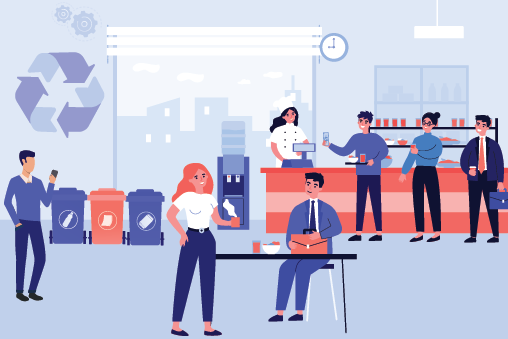Every year, from the farm to the processing plant, the kitchen, and to the table, 1.3 billion tons of food wind up in the bin rather than in our bodies. It’s an astonishing statistic especially when we think of the valuable resources getting wasted. Reducing food waste is an urgent issue to address if we want to reduce our carbon footprint and increase profit margins.
Studies show that more than a third of food goes to waste worldwide. And each ‘actor’ along the supply chain is equally responsible for taking the right actions and collaborating to minimize food wastage. Remember that food wastage has a negative impact on the environment as well as the economy. Office cafeterias are a major source of food wastage, with employees trashing food they didn’t like and cafeteria vendors miscalculating food quantities. Responding to the prevention and reduction of food wastage in an effort towards sustainability and cost control is critical. One efficient way to do this is to employ digital solutions.
Digital tools provide an easy, affordable, and intelligent way to reduce food waste and enable more profitable and sustainable cafeterias. With a digital tracking system, cafeteria managers can visualize actionable data, get analysis and recommendations, and identify the cause and cost of the wastage. They can optimize production volumes and inventory. They will also get a real-time overview of what food they have, how much it’s worth, and when it expires.
Here are some more ways that a digitized cafeteria solution can help:
Inventory Management
Digital inventory management gives a better view of the status of the supplies required basis usage and consumption patterns. Cafeteria managers can avoid spoilage and the resulting wastage by changing their purchase cycle basis these patterns. A digital solution will also enable regular checking of material and more accurate supply audits, while also ensuring the predictability of stock levels.
Digital Order Placement
Online ordering allows for more accurate food management. Employees can use the software, or an app, to browse through the daily and/or weekly cafeteria menus and place their orders via the app. Cafeteria managers can then more accurately calculate the required food quantities, which means less food ends up being thrown away.
Digital ordering also helps employees take control of their order experience and tailor their orders to specific needs with minimal waste, especially because employees have ordered precisely what they want. Orders are captured and routed directly to the cafeteria, where they are filled accurately and completely to employee needs, thus optimizing the entire workflow.
Accurate Employee Feedback
A digital cafeteria management app will allow employees to give real-time and accurate feedback about the food being served. Managers can view this feedback and avoid wastage by optimizing quantities of less popular items. Similarly, cafeteria vendors can also use the digital tool to analyze a variety of data collected and reveal insights that will enable corrective action.
Beyond workflows
Digitized office cafeterias can reduce food wastage, control costs, and increase sustainability. However, even with improved inventory management, supply management, and a streamlined overall cafeteria workflow, without employee awareness, this impact may not last long. It’s easy to forget sustainability best practices when things get hectic and stressful. That’s why it’s important to continuously communicate with employees and follow up with the right communication. The digital cafeteria app can be used to send out repeated communication and remind employees of their roles.
Additionally, flexibility in service, flexibility in the menu, smaller portions with the option of taking second helpings, and prices based on weight can help employees become more aware of food waste.
Key Points
It’s time for office cafeterias and business park food court outlets to take food waste prevention seriously. With the right approach and a feature-rich, easy-to-use digital tool, offices won’t have to make major adjustments to their cafeteria to stop wasting food. Investing in cafeteria digitization makes good business sense in addition to being socially responsible because you will be able to reduce the cost of material and operations and consequently maximize profits.
Digital solutions like GoKhana to help you make this happen. GoKhana is a unique cafeteria digitization solution, which is quick to deploy and affordable to scale. The best feature of GoKhana is that it is visual, easy to use, and employs smart technology to streamline food management.
At the same time, do remember that digital technology alone will not be able to create the fundamental shift required to prevent food waste. Digitized cafeteria solutions must move in tandem with a re-examination of consumption habits and current cafeteria management practices.

